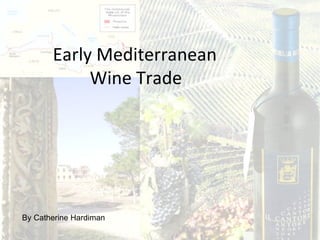
Early mederterranean wine trade
- 1. Early Mediterranean Wine Trade By Catherine Hardiman
- 2. Introduction The history of wine- growing is as old as the ark. When Noah’s ark is said to have come to rest somewhere in the eastern region of Turkey, he planted grapes. Carbon dating of grape pip concentrations amongst pottery remains, found at various sites nearby , estimate that they date back to 5000B.C. Since that time the Egyptians, Phoenicians, Greeks and Romans to name just some, fostered viticulture and the art of wine making, either by establishing vineyards in lands that they conquered, or by trading wine with other peoples for necessary commodities.
- 9. Winemaking in Ancient Greece (800-300BC)
- 10. Greek Wine Trade Routes
- 11. Greek Amphora
- 12. The Gauls
- 13. Gaul Territory
- 14. Gaul Barrels
- 15. The Roman Conquerors (of Gaul)
- 20. References Dal Piaz, G. (2009). Introduction to sweet wine. Retrieved July 30, 2010, from http://www.snooth.com/articles/commentary/a-history-of-wine/ Dal Piaz, G. (2009). The history of wine part three: Wine storage – barrels. Retrieved July 30, 2010, from http://www.snooth.com/articles/commentary/the-history-of-wine-part-ii-wine-storage-barrels/ Dal Piaz, G. (2009). Wine storage – the early days: The basic material – pottery. Retrieved July 30, 2010, from http://www.snooth.com/articles/commentary/the-history-of-wine-part-ii-wine-storage-the-early-days/ Nurse, K. (1994). The last of the (Roman) summer wine. History Today , 44, 1. Pellechia, T. (2006). Wine: The eight –thousand – year – old story of the wine trade. New York: Thunder’s Mouth. Unwin, T. (1996). Wine and the vine: An historical geography of viticulture and the wine trade. New York: Routledge.
Hinweis der Redaktion
- The Egyptians developed the first pruning and vine training records
- Grapes intended for premium quality wine were foot trodden. Juice from successive straining of grapes were used for lesser quality wine. Juice was then stored in earthenware jars with a small aperture until secondary fermentation had taken place, then sealed. Each jar then labelled with details about wine quality and year of vintage. Jars were then buried presumably for temperature control.
- Phoenician shipwrecks have been found containing hundred of jars of wine destined for foreign ports. Phoenicians and their Punic descendants of Carthage (North-East Africa), were keen students of viticulture and wine-making. The Carthaginian writer Mago wrote the viticultural treatise which was to become the most important early text recording ancient knowledge of winegrowing.
- Present day Israel, Lebanon and the coastal part of Syria now occupy Ancient Phoenicia on the East coast of the Mediterranean Sea.
- Vineyards were cut into the hillside on terraces to maximise land usage and sunlight. Ripe grapes were foot-trodden and the juice trickled into clay vats below lined with pitch or resin (“Retsina”- popular resin flavoured Greek wine of to-day) Juice was left to ferment in vats and then after 6 months was pored into amphorae for ease of transport.
- Greece also was a shipping nation and a number of sunken wrecks of Greek merchant vessels bound for Greek colonies in southern Italy or on the Black Sea have been found laden with amphorae.
- The Greeks also carried wine on their journeys and planted vineyards on territories they conquered.
- The ancient Gauls were a celtic people led by Duid priests. They occupied the ancient country of Gaul, an area that to-day consists of France, Belgium, Luxembourg, part of Germany and part the Netherlands. By 390AD the Gauls had moved southward across the Alps and into Northern Italy. Conquered by Julius Caesar in 50AD, Gaul became part of the Roman Empire.
- Long before the Gauls encountered the Romans they had acquired a taste for wine. Either the Phoenicians or the Greeks established the port of Massalia (present day Marseilles) and traded wine with the Gauls so that by 400BC the wine trade was well established. The town of Toulouse (France) has been found to have been built of tens of thousands of amphorae shards dating back to 2 nd -3 rd century BC.
- The Romans were selling wine (very profitably) to the Gauls for at least a century before Julius Caesar conquered the Gauls in 51AD. The wine was sent from Northern Italy in amphorae (in the same way the Greeks had sent it), yet the Roman writers Strabo (died 23AD) and Pliny the Elder (died 79AD) both attested that the Gauls stored the wine in very large wooden barrels held together by hoops.
- The Gauls did not produce wine themselves until after the Romans established a presence in Gaul. During the reign of Caesar Augustus, the Allobroges who controlled traffic in the Rhone valley, found a grape that could survive the frost in that region so that viticulture was able to be established hundreds of miles north of the southern Mediterranean. At the same time in Aquitan, the “Biturica” grape was found and became established in that region now known as Bordeaux. Gaul became a prodigious producer of wine cutting the profits of the Italian (Roman) winemakers.
- Having established a port at Aquitan (near Bordeaux), the Romans went on to conquer what we now know as England. The Romans shipped barrels of wine to England as well. At Hadrian’s wall in England, there are remains of barrels and writings about barrels of wine. (Hadrian died 138AD)